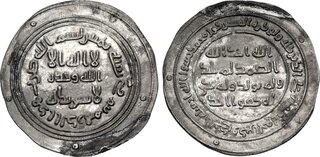| Classical Numismatic Group > Triton XXVII | Auction date: 9 January 2024 |
| Lot number: 979 Price realized: 18,000 USD (Approx. 16,486 EUR) Note: Prices do not include buyer's fees. | Show similar lots on CoinArchives Find similar lots in upcoming auctions on |
| Lot description: Umayyad Caliphate, Silver coinage. AR Dirham (26mm, 2.71 g, 6h). Bamm mint. Dated AH 80 (AD 699/700). Small portion of edge chipped and repaired. Near EF. Of the highest rarity, apparently unique. Founded by the Sasanians, Bamm was a strongly fortified town in the province of Kirman. Its citadel was described by one contemporary writer as being impregnable, but the local water was apparently bad, and a complex network of aqueducts supplied most of the Bamm's water supply. According to Arab geographical writers of the 9/10th century, the town's prosperity was primarly based on dates and especially cotton, which was grown locally and used to manufacture fabric. Speaking of Bamm, the great traveller Ibn Hawqal reported that 'they weave splendid, beautiful and durable cotton garments which are sent to places all over the world. They also make fine clothes, each of which costs around thirty dinars, and these are sold in Khurasan, Iraq, and Egypt.' This is the first Umayyad dirham known from Bamm. It is extremely rare for a new Umayyad dirham mint to come to light, and this is only the second such discovery within the past decade, the other being a coin from the mint of al-Hind, which sold for $140,000 hammer in CNG Triton XXII (8 January 2019), lot 1229. While more than a hundred mints struck Umayyad silver dirhams between AH 78-132, for much of this period only a small number were active at any one time, with production generally centred on Wasit and Damascus. But we can observe two clear periods when this centralised model of Umayyad dirham production clearly did not apply, and as many as forty or fifty different mints were operational in a given year. The first period, to which this coin belongs, spanned the six years between the introduction of the reformed silver coinage in AH 78 and the foundation of Wasit in AH 84. Virtually all of the mints operating during these years were located in the East and had previously issued Arab-Sasanian drachms; this is hardly surprising given that these locations would have already had the personnel, resources and infrastructure to strike the new coins. Almost all of them were closed after AH 84, when dirham production in the East was focused on Wasit. A few years later, dozens of Eastern dirham mints were opened again in AH 90, but not all of those which had been operational from AH 78-84, were reopened, and some of the mints which began striking in AH 90 were completely new. This may suggest that the decision to revert to a decentralised pattern of dirham production in AH 90 was part of a wider series of changes in Umayyad taxation and provincial administration. Bamm was one of those mints which were not reopened, and the recent study by Diler records no further coins being produced there before a small issue of Buwayhid dirhams was struck at Bamm in the 360s. It is surprising that Bamm has not previously been confirmed as an Arab-Sasanian drachm mint. In his latest Checklist of Islamic Coins, Album has tentatively proposed that the Pahlawi mint-signature KRMAN-BN might refer to Bamm (Album p. 21), and this identification is followed by Diler in his monumental Islamic Mints, although the most recent study of the Arab-Sasanian coinage by Malek still considers KRMAN-BN as unidentified. However, the existence of the present coin suggests that Bamm had indeed previously been an Arab-Sasanian mint, as many of the early reform dirham mints were. That being so, KRMAN-BN would seem to be the most likely candidate. Estimate: 30000 USD |  |



